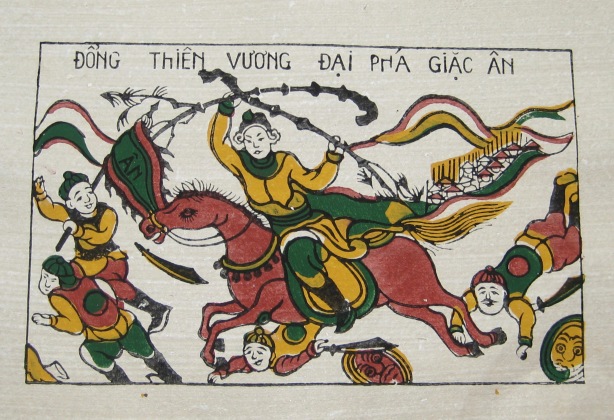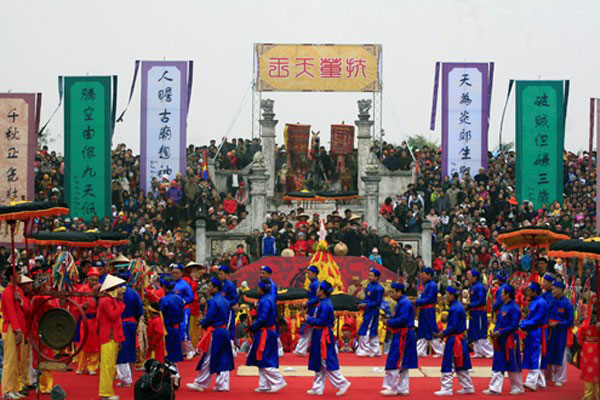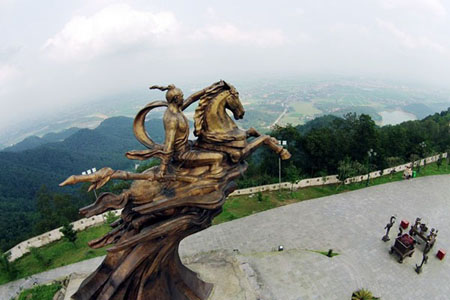The perennial character of a myth is measured by the survival of old folklore practices and the creation of new popular manifestations inspired by it. Typical in this respect is the myth of the god of Giong, or Phu Dong, a village oil on the outskirts of Hanoi, on the far bank of the Red River.
For a decade now, the God of Giong (Thanh Giong), popularly honored with the title of Celestial Prince of Phu Dong (Phu Dong Thien Vuong), has become the patron saint of a broad movement of gymnastics and sports mobilizing millions of primary school children and secondary school students across the country and marked every four years by national junior Olympiads (Hoi Khoe Phu Dong) Those events, although confined to juniors, are as popular as pre-war Czechoslovak Sokols, and are jointly organized by the Education Ministry, the General Department of Gymnastics and Sports, and the Ho Chi Minh Youth Federation. They aim at forming young generations who enjoy good physical and moral health as well as genuine cultural pleasures. Besides, sports competitions (school athletics, artistic gymnastics, volleyball, table tennis, swimming, traditional sports - shuttlecock, wrestling - and art performances - combined maneuvers, group dancing, and singing) make it possible to spot young talent for training and future participation in national and international events.

The success, obtained by the first four junior Olympiads (Hanoi 1983, Ho Chi Minh City 1987, Da Nang 1992, Haiphong 1996, the fifth to be held in Dong Thap in the year 2000) does not mean a slowing down of traditional festivities in Giong village. Far from it, they have known a strong revival over the last decade in the wake of a natural religious and spiritual renascence after the long trials of the war. Each year, four festivals are held in four suburban villages, re-enacting the life and struggle of the warrior of Giong against the invader: in the village of Phu Dong (birth and childhood of the hero, his departure for the war), in the village of Xuan Dinh (a stop he made en route to the battlefield), in Soc Son (his, flight to heaven riding his iron horse following victory), in Chi Nam (he came back to earth to save the people from the ravages of a sea monster).
The major event takes place in Phu Dong beginning on the 9th day of the 4th moon. Hundreds of people take part in the re-enactment of the battle against An invaders. Participants, especially women wearing the costumes of An troops and commanders (hieu), are carefully selected and have to obey numerous taboos. On the 6th day of the 8th moon, a procession brings water drawn from a well in front of the temple dedicated to the Saintly Mother (den Mau) to the temple of God. On the 9th day at the ceremony of the sacrifice, sacred songs and dances of the Ai Lao phuong (quarter) are executed. Then conies the flag dance which symbolizes the unfolding of the battle. The 10th, 11th, and 12th days see the holding of various ceremonies: the waving of flags, the celebration of victory, and of sacrifices to Heaven and Earth. To those events are added popular games and entertainment (cockfighting, swinging, etc.)

Thus, the traditional festivities in Phu Dong and Phu Dong junior Olympiads are held in honor of the God of Giong whose exploits date back to the time when the national identity of Vietnam was shaped (first millennium B.C. Bronze-Iron Age).
Here is the legend, briefly. In the reign of the 6th Hung King, a mature woman of Giong (Phu Dong) village happened to step on the imprint left by a huge divine foot, became pregnant, and later gave birth to a baby boy. For three subsequent years, the child lay in his cot, apparently unable to speak. Invaders from the north came, the An, who created havoc in the country. The king sent a herald to all provinces calling on the people to help defend the kingdom. One day the herald came to the village to make known the king's appeal. It was then that the child rose from his cot and said that he was going to fight the enemy. He consumed an enormous amount of food, grew to a gigantic stature, and asked to be equipped with armor, a spear, and an iron horse. Riding the horse, he plowed through enemy ranks and exterminated large numbers of them. His spear having been broken, he uprooted clusters of bamboo and used them as combat staff. When definitive victory was won, he rode his horse in a flight up to heaven. A cult has been devoted to him in Giong and other localities.
That legend is the first account exalting victory over foreign invaders, a constant feature of Vietnamese history. The God of Giong (Phu Dong) tops the line of the heroic defenders of the country, whose names (the Trung Sisters, Dame Trieu, Le Loi, Ly Thuong Kiet, Tran Hung Dao and others...) have been given to the main streets of Hanoi and other cities.
Certain students of mythology see in the legend of Giong the crystallization of the joys and sorrows, the fears and aspirations of the primitive community of the Viet, relentlessly harassed by climatic hazards and invasions from the north. The traditional festivities of Phu Dong may be thought to be a blend of the cult of fertility (the prayer for rain, indispensable for the growing of rice) and that of the invincible warrior.



